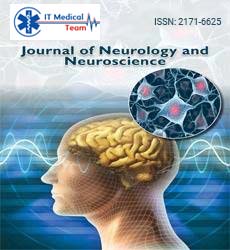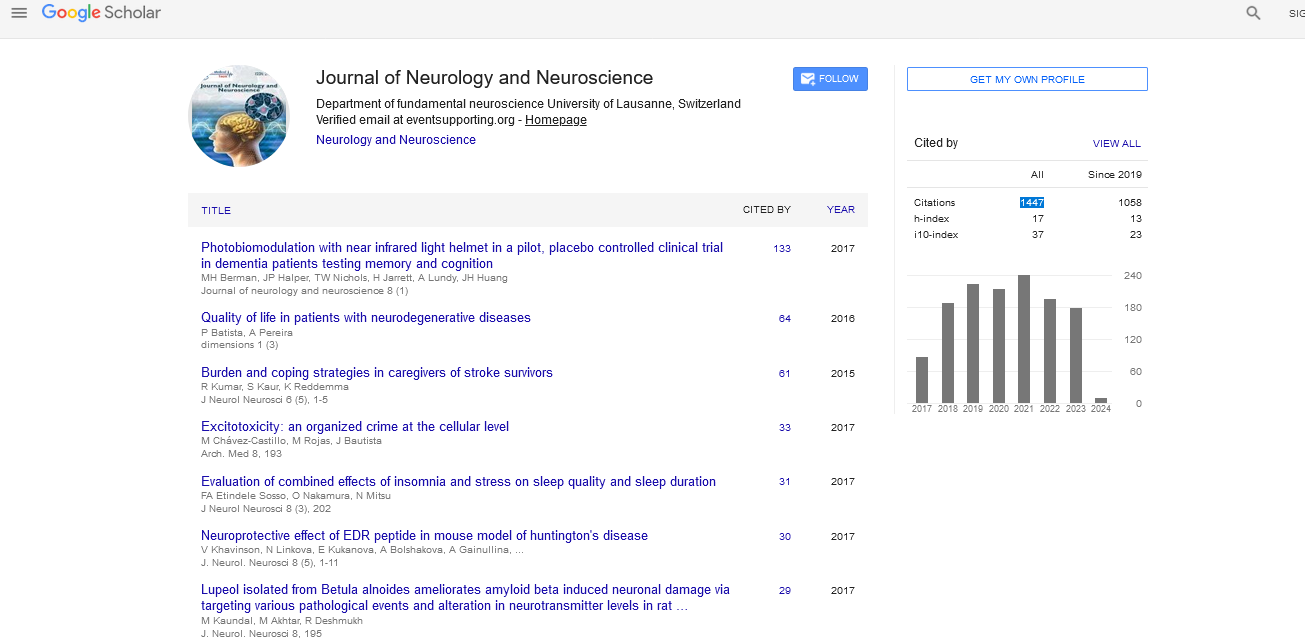Perspective - (2024) Volume 15, Issue 4
Recent advances in psychopharmacology targeting neurotransmitter systems
Paula Ivarola*
Department of Neurology, National Pediatric Hospital, Buenos Aires, Argentina
*Correspondence:
Paula Ivarola, Department of Neurology, National Pediatric Hospital, Buenos Aires,
Argentina,
Email:
Received: 01-Aug-2024, Manuscript No. ipjnn-24-15295;
Editor assigned: 03-Aug-2024, Pre QC No. P-15295;
Reviewed: 15-Aug-2024, QC No. Q-15295;
Revised: 21-Aug-2024, Manuscript No. R-15295;
Published:
28-Aug-2024
Introduction
Psychopharmacology, the study of the effects of drugs on behavior and mental processes, has witnessed significant advancements over the last few decades. These advancements have been primarily driven by a deeper understanding of the neurotransmitter systems involved in mental health disorders. Neurotransmitters, the chemical messengers that facilitate communication between neurons, play a critical role in mood regulation, cognition, and overall brain function. Recent research has focused on various neurotransmitter systems, including serotonin, dopamine, norepinephrine, and glutamate, leading to novel treatment approaches for psychiatric conditions such as depression, anxiety, schizophrenia, and bipolar disorder. This article explores the recent advances in psychopharmacology, particularly in targeting neurotransmitter systems.
Neurotransmitter systems consist of various chemicals and receptors that influence brain function and behavior. The major neurotransmitters involved in psychiatric disorders include: Primarily associated with mood regulation, serotonin impacts emotional well-being, anxiety, and sleep. Dysregulation of serotonin pathways is implicated in depression and anxiety disorders. Often referred to as the "feel-good" neurotransmitter, dopamine is crucial for reward, motivation, and motor control. Its dysregulation is linked to disorders such as schizophrenia, Parkinson's disease, and substance use disorders. This neurotransmitter plays a role in arousal, alertness, and stress response. Its involvement in mood disorders, particularly depression and anxiety, has garnered significant research interest. The primary excitatory neurotransmitter in the brain; glutamate is involved in learning and memory. Abnormal glutamate signaling has been associated with several neuropsychiatric disorders, including depression and schizophrenia [1].
The primary inhibitory neurotransmitter, GABA is crucial for regulating neuronal excitability. It is involved in anxiety disorders, epilepsy, and sleep regulation. Understanding the complex interactions between these neurotransmitter systems is essential for developing targeted pharmacological treatments for psychiatric disorders. SSRIs have been the cornerstone of depression treatment for decades, but recent research has refined our understanding of their mechanisms. New studies suggest that SSRIs may have neurogenic effects, promoting neurogenesis in the hippocampus and enhancing synaptic plasticity. This has led to investigations into how SSRIs might be used not only for depression but also for anxiety and obsessive-compulsive disorders [2].
Recent advancements in drug development have led to the exploration of novel serotonin receptor modulators. For example, compounds targeting the 5-HT2A receptor have shown promise in treating treatment-resistant depression. Drugs like psilocybin (the active compound in magic mushrooms) and LSD have gained attention for their ability to induce profound psychological experiences and facilitate therapeutic change. These substances are thought to work by modulating serotonin receptors, particularly 5-HT2A, leading to enhanced emotional processing and cognitive flexibility. Emerging research highlights the role of neuroinflammation in mood disorders and the potential of serotonin in modulating inflammatory processes. Studies indicate that serotonergic pathways may interact with immune responses, suggesting a bidirectional relationship between the immune system and neurotransmitter signaling. This avenue of research may lead to new therapeutic strategies combining anti-inflammatory agents with serotonergic drugs [3].
Dopamine plays a significant role in reward and motivation, making it a critical target for treating addiction and mood disorders. Recent developments in dopamine agonists, such as bupropion, have shown efficacy in treating depression and Attention-Deficit Hyperactivity Disorder (ADHD) by enhancing dopaminergic signaling. Conversely, dopamine antagonists, primarily used in antipsychotic medications, have undergone significant revisions to minimize side effects while maximizing therapeutic effects. Second-generation antipsychotics, such as aripiprazole, are designed to act as partial agonists at dopamine D2 receptors, providing a more balanced approach to managing schizophrenia and bipolar disorder [4].
The "dopamine hypothesis" of schizophrenia, which posits that excessive dopaminergic activity contributes to psychotic symptoms, continues to guide research in this area. Recent advances have focused on identifying the precise dopaminergic pathways involved in different symptom clusters, paving the way for more targeted treatments. Moreover, the interplay between dopamine and other neurotransmitter systems, such as glutamate, is gaining attention, leading to the development of combination therapies that simultaneously target multiple pathways.
Norepinephrine Reuptake Inhibitors (NRIs), such as atomoxetine, have emerged as valuable alternatives for treating depression and ADHD. Recent studies indicate that enhancing norepinephrine signaling can improve mood and cognitive function in patients with depressive disorders. The dual-action of combining norepinephrine and serotonin reuptake inhibition, as seen in venlafaxine, has shown increased efficacy in treating Major Depressive Disorder (MDD). The relationship between norepinephrine and stress has led to a renewed interest in targeting this neurotransmitter system for anxiety disorders. Understanding how norepinephrine modulates the body's stress response can inform new pharmacological strategies. Drugs that enhance norepinephrine signaling may help mitigate anxiety symptoms by promoting resilience against stressors.
Description
Glutamate has emerged as a critical target in psychopharmacology, particularly for treatment-resistant depression and schizophrenia. Recent studies have shown that modulating glutamate receptors, particularly N-Methyl-D-Aspartate (NMDA) receptors, can produce rapid antidepressant effects. Ketamine, an NMDA antagonist, has garnered significant attention for its ability to induce rapid symptom relief in patients with severe depression. Research into the mechanisms underlying ketamine's effects has led to the exploration of other glutamatergic compounds, such as rapastinel and esketamine, which aim to provide similar therapeutic benefits with fewer side effects. The role of glutamate in cognitive function is an emerging area of research. Dysregulation of glutamatergic signaling has been linked to cognitive deficits in schizophrenia and mood disorders. Investigating drugs that enhance glutamatergic signaling, such as AMPA receptor modulators, may provide novel treatment options for cognitive impairment associated with these conditions [5].
GABAergic drugs, including benzodiazepines, have long been used to treat anxiety and sleep disorders. However, concerns about dependence and tolerance have prompted research into alternative GABAergic agents. Newer compounds, such as non-benzodiazepine anxiolytics, aim to provide anxiolytic effects without the drawbacks of traditional benzodiazepines. Brexanolone, a GABAergic neuroactive steroid, has shown promise in treating postpartum depression, highlighting the potential of targeting GABA receptors for therapeutic intervention. The role of GABA in sleep regulation is also a critical area of research. Enhancing GABAergic signaling may improve sleep quality and address insomnia, which often co-occurs with anxiety and depression. Novel GABAergic compounds that specifically target sleep pathways are being investigated to provide safer and more effective treatments for sleep disorders.
Future directions in psychopharmacology
The future of psychopharmacology lies in personalized medicine, which tailors treatment strategies based on individual neurobiological profiles. Advances in genetic research and neuroimaging techniques enable clinicians to identify specific neurotransmitter system dysregulations in patients. This information can guide the selection of pharmacological interventions, optimizing treatment efficacy and minimizing adverse effects. In addition to pharmacological advances, non-invasive neurostimulation techniques, such as Transcranial Magnetic Stimulation (TMS) and Deep Brain Stimulation (DBS), are gaining traction in psychopharmacology. These methods target specific neurotransmitter systems and brain regions, offering potential therapeutic alternatives for treatment-resistant psychiatric disorders. Combining pharmacotherapy with psychotherapy is gaining recognition as a comprehensive approach to treating psychiatric disorders. Integrating medications that target neurotransmitter systems with evidence-based psychotherapeutic techniques can enhance treatment outcomes and provide patients with more holistic care.
Conclusion
Recent advances in psychopharmacology, particularly in targeting neurotransmitter systems, have significantly expanded our understanding of psychiatric disorders and treatment options. From the exploration of novel serotonergic and glutamatergic compounds to the refinement of dopaminergic and norepinephrine-based therapies, researchers continue to uncover new pathways to optimize mental health treatments. The integration of personalized medicine, neurostimulation techniques, and combined therapeutic approaches promises to shape the future of psychopharmacology, providing hope for individuals suffering from mental health conditions. As our understanding of neurotransmitter systems deepens, the potential for innovative, effective, and personalized treatments becomes increasingly attainable, paving the way for improved mental health outcomes across diverse populations.
References
- Klumperman J, Raposo G. The complex ultrastructure of the endolysosomal system. Cold Spring Harb Perspect Biol. 2014; 6(10):a016857.
Google Scholar, Crossref, Indexed at
- Stuffers S. Sem Wegner C. Stenmark, H. et al. Multivesicular endosome biogenesis in the absence of ESCRTs. Traffic. 2009; 10(7):925-937.
Google Scholar, Crossref, Indexed at
- Parolini I, Federici C, Raggi C, et al. Microenvironmental pH is a key factor for exosome traffic in tumor cells. J Biol Chem. 2009; 284(49):34211-34222.
Google Scholar, Crossref, Indexed at
- Kanemoto S, Nitani R, Murakami T. Multivesicular body formation enhancement and exosome release during endoplasmic reticulum stress. Biochem Biophys Res Commun. 2016; 480(2):166-172.
Google Scholar, Crossref, Indexed at
- Hu P, Wang K, Zhou D, et al. GOLPH3 regulates exosome miRNA secretion in glioma cells. J Mol Neurosci. 2020; 70:1257-1266.
Google Scholar, Crossref, Indexed at





